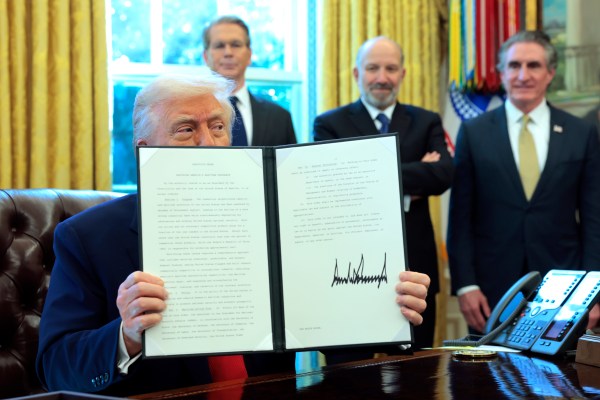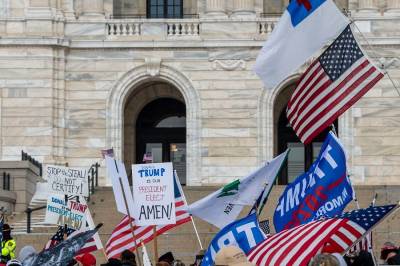Exactly a year ago, a violent mob stormed the U.S. Capitol. The rioters overwhelmed the police who were guarding the building, with many calling for the results of the 2020 presidential election to be overturned. As the nation watched the news that day, we all saw the crowd attacking police, rioters calling for then-Vice President Mike Pence to be executed for his refusal to throw out electoral votes, and those participating in the violence making one thing abundantly clear: They were there because they believed the lies pushed by Donald Trump and his allies that the election had been stolen. But, almost immediately attempts were made to obfuscate what happened that day and remove any blame from fringe Trump supporters.
Figures like Tucker Carlson, Laura Ingraham, and Candace Owens pushed conspiracy theories about the events of January 6. Rather than an attack on American democracy in the name of Trump, they claim that the violence was either justified because the election was stolen or a false flag operation carried out to make Trump supporters look bad and to give the government cover to declare war on them.
A year later, the influence of the conspiracy theorists is clear: Large swaths of the country are convinced the storming of the Capitol was not all that it seemed. In fact, a recent poll from the Washington Post and the University of Maryland found that 19 percent of Americans view the January 6 rioters who entered the Capitol as “mostly peaceful” and 27 percent view them as “equally peaceful and violent.” And so it is important to once again make clear exactly what happened: A mountain of evidence shows that misinformed Trump supporters stormed the Capitol because of the lies they’d been told by the president and his top supporters about the election results.
We won’t get into the election conspiracy theories that led up to January 6—there simply isn’t enough space in one article to cover them, and The Dispatch Fact Check has examined them extensively over the past year. (For more information, see some of our election fact checks here, here, here, and here.) But the conspiracy theories about deleted and changed votes and suspicious vote dumps caused one-third of Americans to question the result of the 2020 presidential election, leading some of them to act on the belief that the election was stolen. At the center of it all was Donald Trump, who spent significant time and energy sowing distrust about the validity of the election and riling up his supporters, including just before violence broke out on January 6. Trump delivered a speech in front of the Save America march, once again promoting a series of debunked voter fraud claims. (The usual suspects: questioning how Joe Biden received a record 80 million votes, railing against “suitcases of ballots” in Georgia that were widely misinterpreted, and falsely claiming that there were more votes cast in Pennsylvania than registered voters.)
Trump told the crowd: “I know that everyone here will soon be marching over to the Capitol building to peacefully and patriotically make your voices heard.” But he also emphasized the need to “fight,” telling the crowd they’d need to “fight like hell” to save the country. “And we fight,” Trump said. “We fight like hell and if you don’t fight like hell, you’re not going to have a country anymore.” This “fight” for a “stolen election,” the very narrative Trump promoted right before the violence, is, of course, the very reason insurrectionists stormed the Capitol that day. He also informed the crowd that Pence could reject electoral votes for Biden: “[A]ll Vice-President Pence has to do is send it back to the States to recertify, and we become president, and you are the happiest people.”
Such language was in keeping with what Trump and his allies had been saying for weeks before January 6. On December 20, 2020, Trump tweeted that it was: “Statistically impossible to have lost the 2020 Election,” and that there would be a “Big protest in DC on January 6th. Be there, will be wild!” Rep. Madison Cawthorn told an audience at a December 21, 2020, Turning Point USA event to “lightly threaten” politicians who didn’t go along with the plan to overturn the presidential election results. In response to a since-deleted December 30 tweet from Rep. Marjorie Taylor Greene in which she said congressional leaders were not going along with the plan to decertify electoral votes, one of the Stop the Steal organizers, Ali Alexander, tweeted: “If they do this, everyone can guess what me and 500,000 others will do to that building. 1776 is *always* an option.”
At an event in Washington on January 5, Alexander led a crowd in a chant of “victory or death” and said, “1776 is always an option. These degenerates in the deep state are going to give us what we want, or we are going to shut this country down.” Trump’s lawyer Rudy Guiliani encouraged Trump supporters who showed up on January 6 to engage in “trial by combat.”
Some rioters chanted, “Hang Mike Pence.” In one video, a woman said “we were looking for Nancy [Pelosi] to shoot her in the friggin' brain, but we didn't find her.” Members of the press who were present were threatened and “Murder the Media” was scratched into a door in the Capitol. Despite what many attempt to claim now, some of the protesters were armed. The police were not stopping the protesters to search them on January 6, but law enforcement still found a number of weapons on those arrested. Law enforcement charged three men with carrying firearms onto the Capitol grounds. Two individuals were charged with having an unlicensed firearm and a pickup truck full of bombs and guns at the protest, though they didn’t bring them onto Capitol grounds. Two pipe bombs were recovered, one outside of the Democratic National Committee headquarters, the other outside of the Republican National Committee’s offices only blocks away from the Capitol.
Shortly after the violence occured on January 6, Trump supporters began to shift the blame for the Capitol violence, claiming Antifa supporters were responsible instead. As we explained in a previous fact check, two related Antifa conspiracy theories were criculating. One claimed that two men at the riot had been identified as Antifa members, and the other claimed that a facial recognition software company identified two Antifa members at the insurrection. And, as we noted, both conspiracy theories seemed to refer to the same two men, but neither has actually been identified as Antifa. One of the alleged Antifa members is in reality a somewhat prominent QAnon believer, and the facial recognition company claimed that it identified two neo-Nazis, not two Antifa members. The Antifa conspiracies spread quickly, with prominent figures like Lin Wood, Sarah Palin, Texas Attorney General Ken Paxton, and Rep. Matt Gaetz sharing the claims on social media and on the House floor. Laura Ingraham also spread a variation of the claim on her January 6 show, suggesting that the insurrectionists might not be Trump supporters because of “those knee pads and all the pads on their elbows,” which she said she hadn’t seen at a Trump rally before.
In fact, as we pointed out, not only was there no evidence to suggest that January 6 insurrectionists were Antifa members—or FBI plants as is sometimes suggested—there was, even before many of the participants were identified, ample evidence to suggest that the participants were indeed Trump supporters. Members of the far-right group Proud Boys—known for attending protests in polo shirts and military armor—posted on Parler about attending the upcoming January 6 protest, with the Proud Boys’ chairman Enrique Tarrio telling followers to show up “incognito” and in “ALL black.” Numerous outlets reported on the presence of the Proud Boys and other similar groups on January 6, with ProPublica and Frontline identifying well-known members of the Proud Boys, far-right militia the Oath Keepers, and white nationalist groups at the riot. Two members of Proud Boys were indicted for “conspiring to obstruct law enforcement, among other charges” because of their involvement in the January 6 riots. Another, the self-proclaimed leader of the Honolulu Proud Boys, was indicted for participating in a conspiracy to obstruct Congress. Social media was filled with members of these groups posting pictures from the riot and bragging about their participation.
As more arrests have been made, more of the rioters have been identified as Trump supporters. More than 650 people have been charged with participating in the January 6 insurrection, but here are just a few participants, in their own words, acknowledging their roles in the riot. Cleveland Meredith Jr., who drove from Colorado to Washington, D.C., to attend the January 6 riot, admitted to a judge, according to NBC News, that he threatened to shoot Nancy Pelosi: “It was political hyperbole, but I did text that,” he said. Although Meredith missed the riot because he arrived late, he acknowledged that he brought 2,500 rounds of ammunition, an assault rifle, in addition to another gun.
Anna Morgan Lloyd pleaded guilty to a single misdemeanor charge under a deal with prosecutors. The Associated Press reports that she told the judge “‘I’m ashamed that it became a savage display of violence that day. And I would have never been there if I had a clue it was going to turn out that way. It was never my intent to be a part of anything that’s so disgraceful to our American people.’” Jacob Chansley, known as the QAnon shaman, was recently sentenced to 41 months in prison. He told a judge: “I was wrong for entering the Capitol. I have no excuse. No excuse whatsoever. The behavior is indefensible.”
The lies about January 6 have birthed further lies, with conspiracy theorists now also claiming that fthe Biden administration began harassing and imprisoning Trump supporters after the events at the Capitol. Tucker Carlson has been a particularly strong amplifier of this conspiracy, dedicating large parts of his “documentary” Patriot Purge to the claim that following January, the Biden administration has launched a “manhunt”. In Carlson’s words: “Since January 6, the Biden administration has launched the biggest and most technologically sophisticated manhunt in American history.”
As evidence that the Biden administration is participating in a “manhunt”, Carlson cites an article from The Intercept, that reports the “CIA is now funding 38 separate companies to identify and spy on social media posts whose opinions the Biden administration disagrees with.”
The Intercept did publish a story about the CIA’s alleged investment in 38 firms that mine tweets and Instagram content. But the story was published on April 14, 2016, more than four years before Joe Biden was elected. This fact goes unmentioned in the documentary.
According to The Intercept: “Among 38 previously undisclosed companies receiving CIA venture capital funding, several are developing tools to mine social media.” However, these tools have nothing to do with identifying “social media posts whose opinion the Biden admin disagrees with.” The Intercept reported that: “The investments appear to reflect the CIA’s increasing focus on monitoring social media.
If we learned anything on January 6, 2021, it’s that disinformation can have dangerous consequences. It is darkly poetic that more lies should come out of what happened that day; those spreading them cannot be allowed to do so unchallenged.







Please note that we at The Dispatch hold ourselves, our work, and our commenters to a higher standard than other places on the internet. We welcome comments that foster genuine debate or discussion—including comments critical of us or our work—but responses that include ad hominem attacks on fellow Dispatch members or are intended to stoke fear and anger may be moderated.
With your membership, you only have the ability to comment on The Morning Dispatch articles. Consider upgrading to join the conversation everywhere.